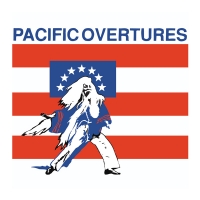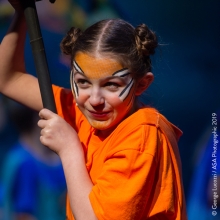
Full Synopsis
Act One
Three Japanese musicians enter and take positions on a low platform at the side of the stage and play their instruments. The stage and the auditorium go black. The stage and house lights come up revealing the Reciter in front of the show curtain, forehead touching the floor in deep prayer.
The Reciter rises and introduces Nippon, The Floating Kingdom: an island empire that for centuries has lived undisturbed by intruders. There was a time when foreigners were welcome there, but they took advantage of Nippon's friendship. They were driven out two hundred and fifty years ago by sacred decree and ordered to never set foot on the ancestral soil. From that time on, there has been nothing to threaten their consistent state of peace ("Advantages").
A Japanese prisoner in Western dress enters and is taken to the Shogun's court to be examined, but the Shogun is not there. Instead, Lord Abe, First Councilor to the Shogun, questions the man, who is identified as John Manjiro. He is a Japanese fisherman who is dressed in Western garb because, several years prior, he was rescued at sea by Americans and taken to Massachusetts. He has returned from America to Japan, despite facing the death penalty twice over - once for having left, and once for having returned - to warn his countrymen of the rumors that America is planning to send an expedition to Japan. The Shogun's councilors doubt Manjiro and sentence him to death. However, they cannot rule out the possibility that he may be right and begin preparations to deal with the Americans should they arrive.
The Shogun's Councilors approach Kayama Yesaemon, a samurai of little consequence. They inform Kayama that they have selected him to be Prefect of Police of the City of Uraga. He must meet the Americans when they arrive by taking a boat to their ships, and order them to leave immediately. Kayama has no choice but to accept the responsibility. He returns to his wife, Tamate, and tells her the news. At first, she is happy with his promotion but he explains it is a death sentence that has been given to him because none of the Shogun's Councilor's want the job. If he tells the ships to leave and they do not, he will have failed; he will be disgraced and have no choice but to take his own life. Tamate insists there is an alternative, Kayama assures her there is not ("There Is No Other Way").
A bell sounds in the distance, signaling that the Americans have arrived. A Fisherman notices the American ships off the coast. People flee and different laypeople express what they see as the ships approach ("Four Black Dragons"). Meanwhile, on the deck of the U.S.S. Powhatan, sailors stand at attention. The leader, Commodore Matthew Calbraith Perry, is revealed. Kayama approaches the American ship, crouching in a tiny guard boat. He tells the Americans to leave, but they have no interest in talking with the Prefect of Police. They tell Kayama they wish to only speak with the Councilors.
Kayama reports this information to the Councilors. He devises a plan with them to have Manjiro pose as a Councilor and deal with the Americans. Manjiro gets the Officers' attention, but Commodore Perry will only speak with the Shogun. He then presents a letter from President Millard Fillmore: the Japanese have six days to prepare a ceremony, in which the Commodore will bring the letter to the Shogun on land. Manjiro protests but the Americans do not budge. The only choice left is to get Tokugawa Ieyoshi - the Shogun - to deal with the Americans. Abe, Manjiro and Kayama go to visit the Shogun in his court. He is not well and is attended by his wife, mother, physician and soothsayer. The days pass and as the Shogun is unable to take action, his mother decides to solve the problem by making it so that there is no Shogun to receive the letter. She prepares a special tea, with poison mixed in, for her son ("Chrysanthemum Tea"). He drinks it and promptly dies.
Despite the Shogun's death, the Americans' maintain their intentions of coming ashore to deliver the letter; the Head Councilor orders that Kayama and Manjiro be killed but Kayama reveals that he has a plan. He believes the Americans should come ashore, but only at Kanagawa where there is a small cove. Provided they cover the sand with mats, and build a special treaty house in the cove, the Americans can deliver the letter without setting foot on Japanese soil. After the meeting, they plan to destroy the house and the mats. The Councilors agree to the proposal and promote Kayama to Governor of Uraga. Kayama also gets them to revoke Manjiro's death sentence. Kayama then returns to his wife in Uraga, and he brings Manjiro with him for company. As they travel, Kayama and Manjiro compose poems for their two loves, Tamate and America, respectively ("Poems").
Upon their return, Kayama runs inside his house leaving Manjiro outside. He excitedly relays what has happened, and does not notice that Tamate is still turned away from him in a kneeling position at the household shrine. He discovers that Tamate, thinking he is dead, has already killed herself. He is heartbroken but composes himself and rejoins Manjiro without saying a word.
As they exit, a garish middle aged Madame enters leading four reluctant girls to meet the Americans - she explains that her regular girls have fled in fear. She instructs the girls as to how best meet the American men and make them feel 'comfortable' ("Welcome To Kanagawa").
The Americans prepare a variety of gifts to take with them when they go on land, all of which depict Western Culture. The Japanese Councilors have only a few exquisitely wrapped packages, each carefully selected, which reflect some aspect of the Japanese craftsmanship and culture. The Americans deliver the vast array of gifts and look a bit skeptically at the few Japanese presents. The Americans insist that their mission is a peaceful one, but the Japanese are unable to trust them. They have assembled an army on horseback to intimidate the Americans, but the Americans laugh at them.
Meanwhile, in Commodore Perry's personal journal, he writes that he hopes the Japanese will accept the reasonable and 'pacific overtures' embodied in his friendly letter to them. If they refuse to join the rest of the world and insist on standing alone in isolation, then he will use whatever means necessary to introduce them to the rest of the world.
The Councilors wait for the Americans to arrive at the treaty house. The Reciter then informs the audience that there is no record of what was said inside the treaty house, except for the American one, which is not trustworthy. He laments the absence of an authentic Japanese account of what took place. An old man steps forward, explaining that as a small child he hid in a tree and watched the proceedings. He begins to tell what he saw; he is joined by a samurai warrior who tells what he heard, while he was hidden under the floorboards. Together they piece together the record of the event ("Someone In A Tree").
After the meeting, the Japanese destroy the mats and the treaty house as planned. The Westerners have been kept at bay for the next two hundred and fifty years, or that is what the Japanese believe. The lion-like figure of Commodore Perry jumps out performing a strutting, leaping dance of triumph. He exits waving two American flags.
Act Two
The Reciter enters and kneels at the side of the stage. The curtain rises revealing the Imperial Court in Kyoto, the Emperor, a Priest, and two bored Nobles. Though the Emperor is the sacred ruler of Japan a thousand years ago, his power was wrested from him by the warlord named Shogun and since that time, the Emperor has ruled in name alone. Even though the court supposedly rules over the Emperor, they still lie down in homage before him out of respect. The Emperor is very happy that the Americans did not set foot on Japanese soil and he acknowledges Lord Abe Mashiro as the thirteenth Shogun of the Empire of Japan. The Emperor formally acknowledges Kayama Yezaemon as Governor of the City of Uraga and, finally, the Emperor rescinds the sentence of death imposed on the fisherman Manjiro. He is elevated to the rank of samurai. They all believe the Americans will not be back.
Abe is surprised by the sudden sound of a marching band. An American Admiral enters, carrying a plaque and some official documents. The Admiral informs Abe that the Americans are back for a much longer visit. After an American cannon fires, Abe feels he has no choice but to sign a document letting them come back. Suddenly, a British Admiral appears with a letter from Queen Victoria demanding that the British be allowed to use the port for trading purposes. Hearing a British explosion, Abe reaches for these documents and signs them. A Dutch Admiral then enters and demands that Abe sign a treaty with him. Soon, a Russian Admiral appears for the same purpose, and then a French; Abe is forced to open the country to all of the Westerners ("Please Hello").
Despite the Emperor's displeasure with the Western presence in Japan, it is moving forward. Kayama writes a series of letters to Lord Abe telling him of the Westerners' expansion over the next 8 years. Soon, Kayama, along with much of Northern Japan, is transformed by Western traditions ("A Bowler Hat"). Mr. Jonathan Goble, a marine who once visited Japan ten years ago aboard one of Perry's ships, now returns to bring an American invention. He claims it will revolutionize all forms of city transport in Japan: rickshaws will be in every major city, pulled by the Japanese.
Elsewhere, Manjiro and other samurai practice their famous sword fighting. A beautiful Japanese woman in traditional garb sets out tea and watches them practice. Three British sailors watch her, believe that she is a geisha girl. They climb over a small fence and try to solicit her ("Pretty Lady"). However, when she calls for her father, they realize they are mistaken. It is too late and one is murdered by a samurai. Kayama reports the incident of the murdered sailor to Shogun Abe. They have sent a letter of apology to Queen Victoria and hope that all will be forgiven. The samurai have been reprimanded, but Kayama worries that it is unwise to punish them. Certain people of the Japanese South are treating them as heroes. Abe, however, is of the opinion that they must appease the Westerners until the Japanese have learned the secrets of their power and success. Samurai assassins enter and kill Abe. Kayama is left with a cloaked Samurai who reveals himself to be Manjiro. Kayama doesn't understand his transformation from the days when Manjiro loved the West, but Manjiro explains he was an ignorant country boy. They fight and Manjiro kills Kayama.
The Emperor's Lords of the South enter and thank Manjiro for standing up for Japan and killing the Shogun. They salute isolationism in the name of the Emperor. The Emperor appears for the first time, and says that his word will be law once more. He states that from that day forward, all samurai will put their swords aside and take up useful trades as Japan will turn its back on ancient ways and open itself up to the rest of the world. Not only will they match the West, they will surpass the Westerners at their own methods ("Next").
Show History
Inspiration
Bookwriter John Weidman got the idea for the show while in college, where he studied Asian history. It was originally a play, but when director Harold Prince read it, he suggested turning it into a musical with Stephen Sondheim. Prince and the authors flew to Japan on several occasions to study Japanese culture and theatre -- of which Sondheim and Prince knew little -- and returned with the basis for a uniquely-conceived work of art commenting on "progress" and its effects on the individual and society.
Productions
Pacific Overtures previewed in Boston and then ran at The Kennedy Center in Washington, D.C. for a month before opening on Broadway at the Winter Garden Theatre on January 11, 1976. It closed after 193 performances on June 27, 1976. Directed by Harold Prince, the choreography was by Patricia Birch, scenic design by Boris Aronson, costume design by Florence Klotz, and lighting design by Tharon Musser. The original cast included Mako as the Reciter, Sab Shimono as Manjiro, Isao Sato as Kayama and Gedde Watanabe as the Priest/Boy in "Someone in a Tree."
Pacific Overtures was revived off-Broadway in 1984 with a partially European cast, and underwent a few revisions by the authors. The English National Opera also presented a European-cast version, which was very successful.
A critically acclaimed 2001 Chicago Shakespeare Theater production, directed by Gary Griffin, transferred to the West End s Donmar Warehouse, where it ran from June 30, 2003 until September 6, 2003.
A Broadway revival ran at Studio 54 from December 2, 2004 to January 30, 2005, directed by Amon Miyamoto and starring several members of the original cast and B.D. Wong as the Narrator.
Cultural Influence
- The original cast recording was first released by RCA Records in 1976.
- The original Broadway production was filmed and broadcast on Japanese television in 1976.
- The English National Opera production was recorded in full -- scenes and all -- by John Yap of That's Entertainment Records. A highlights version is also available of that recording. The score has since entered the repertoire of several prominent opera companies.
- A new Broadway recording of Pacific Overtures, with new (reduced) orchestrations by orchestrator Jonathan Tunick, was released by PS Classics on May 10, 2005. This recording featured additional material not included on the original cast album.
Trivia
- Pacific Overtures was the fourth outing for composer/lyricist Stephen Sondheim and director Harold Prince, and by far their most daring.
- Sondheim has been quoted as saying "Someone in a Tree" is one of the best things he has ever written. Furthermore, Prince and others believe that "A Bowler Hat" is one of the most perfect moments in musical theatre ever written.
- The original Broadway production was nominated for 10 Tony Awards, and won Best Scenic Design (Boris Aronson) and Best Costume Design (Florence Klotz).
- The London production in 2004 was nominated for 7 Olivier Awards, winning Best Theatre Choreographer and best Lighting Design in addition to Outstanding Musical Production.
- The Broadway revival was nominated for 5 Tony Awards in 2005.
- Harold Prince has won more Tony Awards than anyone else (20): eight for directing, eight for producing, two as producer of the year's Best Musical, and two special Tony Awards.
- Pacific Overtures played in New York City four times: the original 1976 production, and three revivals: 1984 (The York Theatre, which transferred to the Promenade), 2002 (Lincoln Center - in Japanese!) and 2004 (Roundabout Theatre at Studio 54).
Critical Reaction
"The lyrics are totally Western and as is the custom with Mr. Sondheim devilish, wittily and delightfully clever& the music and lyrics are as pretty and as well-formed as a bonsai tree. Pacific Overtures is very, very different." - The New York Times (1976)
Drama Desk Award
Tony® Award
NY Drama Critics Circle Award
Connect
LucilleLortel Archives (Original)
PlaybillVault (Broadway Premiere)
Billing
- Book by
- Music and Lyrics by
- Additional Material by
Requirements
|
Music and Lyrics by
STEPHEN SONDHEIM
|
Book by
JOHN WEIDMAN
|
Orchestrations by Jonathan Tunick
Original Broadway Production Directed by Harold Prince
and Produced by Harold Prince in association with Ruth Mitchell
Included Materials
| Item | Quantity Included |
|---|---|
| ERRATA LIST | 1 |
| LIBRETTO | 25 |
| PIANO CONDUCTOR'S SCORE | 2 |
| VOCAL BOOK | 25 |
Production Resources
| Resource |
|---|
| HOW DOES THE SHOW GO ON-10/CS |
| HOW DOES THE SHOW GO ON? |
| REFERENCE RECORDING |
STANDARD ORCHESTRATION
| Instrumentation | Doubling |
|---|---|
| BASS | |
| CELLO | |
| HARP | |
| HORN | |
| KEYBOARD 1 | CELESTE , RMI |
| PERCUSSION | ANVIL , BELL TREE , BELLS , CHIMES , GONG , RACHET , SUZU , TAM-TAM , TEMPLE BLOCKS , TRIANGLE , TYMPANI , XYLOPHONE |
| PERCUSSION 2 | BELL PLATE , BELLS , CLAPPERS , SHAMISEN , STAGE DRUM , TEMPLE BLOCKS , WOOD BLOCK , XYLOPHONE |
| PERCUSSION 3 | |
| REED 1 | ALTO FLUTE , FLUTE , PICCOLO , RECORDER |
| REED 2 | Bb CLARINET , Eb CLARINET , FLUTE , PICCOLO |
| REED 3 | BASS CLARINET , CLARINET , FLUTE |
| REED 4 | ENGLISH HORN , OBOE |
| REED 5 | BASSOON , CLARINET |
| TROMBONE | |
| TRUMPET | |
| VIOLA | |
| VIOLIN |
ALTERNATE ORCHESTRATION
| Instrumentation | Doubling |
|---|---|
| ALT:ERRATA OFF-BROADWAY VERS. | |
| ALT:KEYBOARD | |
| ALT:PERCUSSION | BAMBOO WIND CHIMES , BELL TREE , BELLS , BONGO , CALF-HEADED DRUM , CASTANETS , CHINESE CYMBAL , CLAVE , COWBELL , FINGER CYMBAL , GLOCKENSPIEL , GONG , KIT , LOG DRUM , MARACAS , RACHET , ROTO TOM , SLAPSTICK , TAM-TAM , TAMBOURINE , TEMPLE BLOCKS , TRIANGLE , WIND CHIMES , WOOD BLOCK , XYLOPHONE , YARNS |
| ALT:PIANO/CELESTE | CELESTE , PIANO |
| ALT:REED | CLARINET , FLUTE , PICCOLO , RECORDER |




